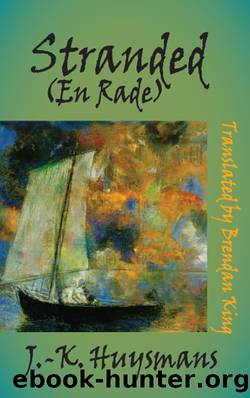Stranded by Joris-Karl Huysmans

Author:Joris-Karl Huysmans
Language: eng
Format: epub
ISBN: 9781909232112
Publisher: Dedalus Ebooks
Published: 2012-07-27T00:00:00+00:00
Notes
*116.ââ¦French kickboxer. Huysmans uses the phrase maître de savate, savate being a form of kickboxing introduced into France at the beginning of the nineteenth century. It was popularised by fighters such as Charles Lecour during the mid-1850s, and later by Joseph Charlemont, who not only wrote kickboxing training manuals but established a boxing academy in Paris in 1887. Huysmans also made a reference to savate in A Rebours. It is possible that he saw an exhibition bout during the period he frequented cirques and musichalls.
*116a.ââ¦uterine metritis. An inflammation of the lining of the uterus. In the nineteenth century it was common to associate âneuroticâ or âhystericalâ symptoms with diseases of the womb or uterus.
*116b.ââ¦a spell of adynamia. A medical condition characterised by a loss of strength and vigour.
*117.ââ¦illness whose roots extended everywhere. This is an obvious play on Pascalâs well-known quote about Nature being âan infinite sphere whose centre is everywhere and whose circumference nowhereâ. However, Pascal had adapted his quote either from Saint Augustine, who in his Confessions defined God as being âwholly everywhere, but nowhere limited in spaceâ, or from the twelfth century Book of Propositions attributed to the fabled alchemist, Hermes Trismegistus, who defined God as âan infinite sphere whose centre is everywhere and whose circumference is nowhereâ. As Huysmans was familiar with all three sources itâs not clear which author he was specifically pastiching.
*117a.ââ¦a magisterium concocted by a Bolognese count. The German alchemist Martinus Rulandus (1569-1611) defined âmagisteriumâ in his Lexicon alchemiae (Lexicon of Alchemy, 1612) as: âa Chemical State which follows the process of extraction, and in which a matter is developed and exalted by the separation of its external impurities. In this manner are all the parts of natural and homogenous concretion preserved. But they are so exalted that they almost attain the nobility of essences.â
*117b.ââ¦Count Mattei. Born in Bologna to a wealthy, aristocratic family, Count Cesare Mattei (1809-1896) studied natural science, anatomy, physiology and pathology, before going on to formulate his theory of electro-homeopathy during the 1870s. Mattei used plant extracts as the active agent of his materia medica, which he prepared by a method borrowed from Paracelsus known as cohobation. Mattei made huge claims for his new treatments and they quickly spread throughout Europe during the latter half of the nineteenth century: by 1884, for example, there were 79 distribution centres in 10 European countries. A French translation of Matteiâs most famous work, Ãlectro-homoeopathie, principes dâune science was published in 1879, ( See Figure 6 Here) but it is unlikely that Huysmans had seen a copy before working on En Rade, as his descriptions are a little imprecise. In fact Mattei stained his âliquid electricâ cures not just green but red, white, straw yellow and blue, in order to distinguish between them. âGreen electricityâ was intended for use to âcalm the pains of cancerous lesionsâ, but could be used âfor all sorts of wounds,â and above all for âpains in the jointsâ. After En Rade was published Huysmans told several of his
Download
This site does not store any files on its server. We only index and link to content provided by other sites. Please contact the content providers to delete copyright contents if any and email us, we'll remove relevant links or contents immediately.
The Fine Print (Dreamland Billionaires Book 1) by Lauren Asher(2493)
Fury of Magnus by Graham McNeill(2397)
The Last House on Needless Street by Catriona Ward(2296)
The Rose Code by Kate Quinn(2145)
A Little Life: A Novel by Hanya Yanagihara(1927)
Malibu Rising by Taylor Jenkins Reid(1854)
Luster by Raven Leilani(1845)
Transcendent Kingdom by Yaa Gyasi(1808)
Moonflower Murders by Anthony Horowitz(1794)
The God of the Woods by Liz Moore(1707)
The Lost Book of the White (The Eldest Curses) by Cassandra Clare & Wesley Chu(1613)
This Changes Everything by Unknown(1468)
The Midwife Murders by James Patterson & Richard Dilallo(1435)
The Lying Life of Adults by Elena Ferrante(1394)
The New Wilderness by Diane Cook(1392)
Wandering in Strange Lands by Morgan Jerkins(1372)
Written in the Stars by Alexandria Bellefleur(1356)
Ambition and Desire: The Dangerous Life of Josephine Bonaparte by Kate Williams(1342)
The Lying Life of Adults by Elena Ferrante;(1272)
